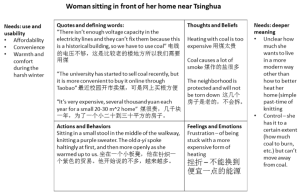Project update from Christina Zhou, Elsa and Noelle Herring
The past few days, we’ve been working to understand the heating situation near Tsinghua University across a variety of building types, ranging from old hutong style buildings to campus coffee shops. Types of technologies we’ve seen range from coal stoves to district heating.
One key interview that stood out was one with an old woman who had lived in the historical preservation buildings near campus. To get her to talk more freely, we focused not only on the logistics of her coal use, but also the feelings involved. She was frustrated with the inconvenience and cost of the coal, on top of the health impacts from breathing in so much smoke the winter. She didn’t like that the building’s historical preservation status meant that it was impossible to redevelop the electricity, which couldn’t handle additional voltage for electric heaters. Moving forward, we will be doing research online (Taobao!) to see prices for coal and get a better sense of building efficiency improvements, and capture additional insights.
这几天,我们对清华附近的供暖情况进行了调查。包括很多不同的建筑类型,比如老的胡同里的供暖情况以及校园里的咖啡厅的供暖情况。他们使用的供暖技术包括:自供暖(小锅炉)以及集中供暖。
其中比较重要的一个访谈是与一个住在学校二校门附近的住户。在访谈中,我们不仅仅关注她是如何使用锅炉进行自供暖的,同时还询问了她对于这种供暖方式的感受。她并不喜欢自己烧锅炉取暖,原因不仅仅是因为买煤非常贵,更重要的原因是自己烧煤会有很多烟,对身体不好,也非常不方便,他们希望可以接受集中供暖,但是由于她所居住的房子是文物保护建筑,所以没有办法进行改造,并且在未来也暂时没有相关的改造计划。往前走,我们要网上查价格和别的保暖的方法,和跟别的人讲话.
Notes!
Apartment + Roofs – Dongheyan Community (公寓合屋顶 – 东河沿社区)9/15
We talked with two men pointing at and observing some roof construction. One worker was hanging off a ladder hammering supports. He said that it takes about two days to complete the retrofit, which makes the home warmer and keeps heat inside the house. For a typical small roof spanning two windows, it costs 6000 yuan. The building currently uses natural gas heating, a rarity in our observations.
Walking down the road, we spoke with an approximately 70 year old resident of the apartment complex, who said the apartments were a little old and small. When we asked him about the heating situation, he confirmed that it was natural gas, and added that the price was about 1600 yuan for a four month billing cycle each year, not a heavy burden at all. He also mentioned that the roof helped with cooling on top of heating.
Leaving the complex, we spoke with a woman with a baby who estimated rent at 3000 yuan / month, for a typical one or two bedroom apartment.
RETURN TO ROOF! Next day 9/16
Confirmed two day time frame
Redoing retrofit – not actually making major improvements to the insulation ability, but just maintaining it.
Side note: Saturday – Tianjin Ecocity (9/13)
Started building in 2007
Buildings only finished for 1-2 years
Solar used for electricity and hot water
Geothermal for AC, heating, space heating only in commercial industries on island
Residential: does not use geothermal, use outside power station, district heating provided Tianjin.
Note: first hutong we visited (with the museum) also uses geothermal energy but was very expensive (don’t recall a number unfortunately)
Tuesday 9/16: Coal, Cafes, and Supermarkets
Cafes part two:
LAN Café: at Tsinghua, near dining hall. Several hundred yuan per year. No space heater (小太阳, 电暖器) because they are prohibited because they are a fire hazard. They don’t have curtains or anything to keep in heat because the space if small, and it would be bad for business.
Ten Years Café: In contrast, the nearby Ten Years Café, also on campus, was designed to save energy, especially with heating in the winter. The staff there pointed out their windows, which were thicker and the sides were well sealed to prevent too much heat loss. There were also two layers of doors. That café used AC because it was built recently (2 years ago), and didn’t have district heating.
Small street in Tsinghua campus that uses coal
Early morning: passed two coal piles – one that was rougher and irregular, and another with cylindrical pieces. Later Elsa explained that the rougher pieces were for heating hot water pipes that also heated the home, while the cylindrical pieces or “honeycomb coal"蜂窝煤was for coal stoves directly heating the home.
Later in the day, we returned for some interviews:
Old woman:
Every year 4-5 tons of coal are used for a 20-30 m^2 home. They can’t use an electric heater because there isn’t enough voltage in the electric lines. This community will not be torn down and rebuilt in the future because it is considered historical and too old (built about 100 years ago), but some nearby houses (yiqu 一曲) will be. They buy coal online from Taobao, though the university has recently of fered coal that can be picked up at a central location. Taobao coal will deliver coal to the home so it’s more convenient. Every year it costs several thousand yuan.
Young guy – 2000 yuan, 50 m^2 for district heating (slightly down the street). However, he will add kongtiao before and after the heating turns on. He didn’t add the extra roof insulation himself – it was there before me. “Bai hui he cao – lime and straw” comprises the material in the roof. It’s very warm in the winter from district heating so no need to add additional insulation measures.
Supermarkets!
On campus supermarket 照澜苑超市. 35 yuan for a one-person electric blanket. 45 for a two-person electric blanket. Not the main source of heat, but people still buy them.
Lotus: 69-249 for electric blankets. Radiator (with oil inside) – 399 yuan.
